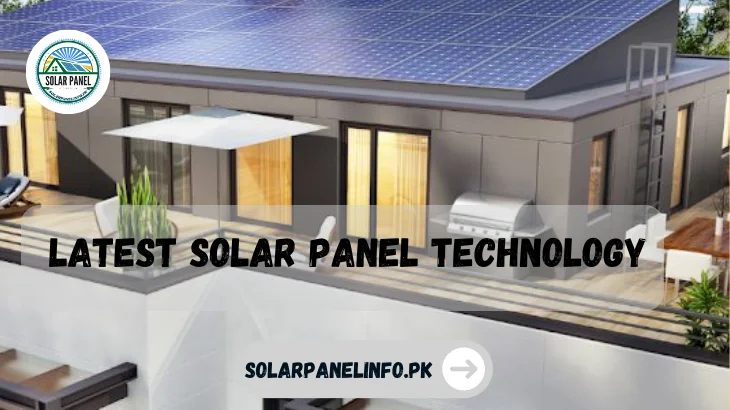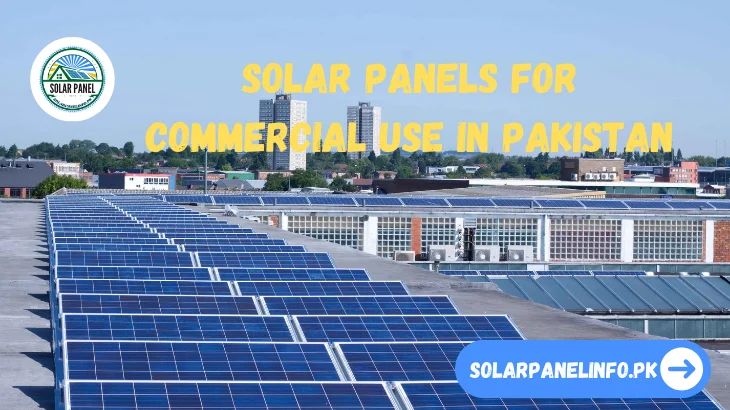Latest Solar Panel Technology
Solar panel technology is advancing quickly, making energy manufacturing more successful, cheap, and environmentally friendly. Revolution-like perovskite-silicon tandem cells, bifacial panels, and transparent solar panels are shifting the industry. In addition, AI-driven efficiency, flexible panels, and modified energy storage increase precision. These developments are clearing the way for a greener and more cost-effective future. Here we will discuss about Latest Solar Panel Technology.
Read more: Night Solar Panel Prices in Pakistan

سولر پینل ٹیکنالوجی تیزی سے ترقی کر رہی ہے، جس سے توانائی کی پیداوار زیادہ کامیاب، سستی اور ماحول دوست بن رہی ہے۔ انقلاب کی طرح پیرووسکائٹ-سلیکون ٹینڈم سیل، بائی فیشل پینلز، اور شفاف سولر پینلز صنعت کو بدل رہے ہیں۔ اس کے علاوہ، AI سے چلنے والی کارکردگی، لچکدار پینل، اور ترمیم شدہ توانائی ذخیرہ کرنے سے درستگی میں اضافہ ہوتا ہے۔ یہ پیشرفت ایک سبز اور زیادہ سرمایہ کاری مؤثر مستقبل کے لیے راستہ صاف کر رہی ہے۔
Types of Latest Solar Panel Technology
- Bifacial Solar Panels
- Thin-Film Solar Panels
- Polycrystalline Solar Panels
- Perovskite Solar Panels
- Monocrystalline Solar Panels
Read more: Monocrystalline Solar Panel Prices in Pakistan.
High-Efficiency Solar Panel Trends
Solar panel performance is better with cutting-edge technology, allowing much energy to be created from smaller surfaces. Key trends include:
- Perovskite-Silicon Tandem Cells – Increases performance beyond 30% by combining perovskite with traditional silicon.
- Bifacial Solar Panels – Capturing sunlight from both sides to increase energy output.
- Quantum Dot Solar Cells – Using nanotechnology to improve light absorption and change.
- Multi-Junction Solar Cells – Layering different materials to maximize performance.
- AI-Optimized Solar Tracking – Increase solar panel positioning for maximum sunlight exposure.
Future of the Latest Technology Solar Panel
Technology constantly evolves. Here’s a snapshot of the future and whether it’s worthwhile to hold up your installation until the trends fully explode!
Perovskite Solar Cells:(پیرووسکائٹ سولر سیل)
Perovskite cells, which break records with efficiencies over 30% in the lab, are considered the solar industry’s future. They offer the flexibility to be used on surfaces where silicon can’t be used.
However, perovskite is still in its early development stages. While it might be ready for large-scale installations within a decade, the mass adoption of perovskite solar cells for the residential sector is still a pipe dream, primarily because of their high cost.
Transparent Solar Panels:(شفاف سولر پینلز)
Production of electricity through windows and glazing is made possible by translucent solar technology, which maintains vision. Thin-film panels have potential for businesses because of their structural conformity and ability to draw energy from each glass appear, even though they are not suitable for wide home use in India.
Heterojunction Solar Cells:(Heterojunction سولر سیلز)
To improve the efficiency of solar cells, heterojunction technology (HJT) combines crystalline and amorphous silicon layers. Higher rates of efficiency are the result of HJT cells’ better utilization of sunlight and reduced electron recombination. Because of their bigger temperature coefficient, they also perform well in hot weather.
Tandem Solar Cells:(ٹینڈم سولر سیلز)
Tandem solar cells combine different photovoltaic materials, like silicon and perovskites, to capture a wider spectrum of sunlight, resulting in higher electricity conversion efficiency. This approach overcomes the efficiency limits of single-material solar cells. As research advances, tandem technology is anticipated to become more affordable and scalable, potentially making ultra-high-efficiency solar panels the standard.
Thin Film Solar Cells:(پتلی فلم سولر سیلز)
Because of their flexible and lightweight layout, thin-film solar cells can be used on an array of surfaces, increasing the variety of solar installations. Their versatility enables new uses of solar power, such as mobile devices and non-traditional connections. Usually cheaper to generate than silicon-based cells, thin-film solar cells provide a reasonable choice for huge-scale installations.
Floating Solar Farms:
Floating solar farms are installed on lakes and reservoirs, addressing land use challenges. They enhance efficiency by staying cool due to the water beneath the panels and help conserve water by reducing evaporation from water bodies.
AI-Optimized Energy Systems:(تیرتے سولر فارمز)
Integrating AI with solar systems can enhance their intelligence and efficiency through:
- Forecasting energy production and demand for optimal distribution
- Real-time monitoring for predicting maintenance needs, reducing downtime, and costs
- Improved integration with the grid to balance supply and demand
Despite AI technology being in the early phases and taking time to fully develop, it is recommended to install solar panels now due to rising electricity tariffs.
Next-Generation Solar Cell Materials
Perovskite Solar Cells: The Game-Changer:(پیرووسکائٹ سولر سیلز: گیم چینجر:)
- High Performance: Perovskite-based solar cells have surpassed 30% performance in lab conditions, rivaling traditional silicon panels.
- Low-Cost Manufacturing: These cells can be produced using solution-based techniques, making them cheaper to manufacture.
- Challenges: Stability issues, degradation under moisture and heat, and the presence of toxic lead require further research for large-scale adoption.
Tandem Solar Cells: Combining the Best of Two Worlds:(ٹینڈم سولر سیلز: دو جہانوں میں سے بہترین کا امتزاج)
- Layered Approach: Tandem solar cells capture a broader spectrum of sunlight by stacking multiple photovoltaic materials (e.g., perovskite over silicon).
- Efficiency Boost: This method allows efficiency rates to exceed 35%, surpassing the limits of single-material cells.
- Commercial Viability: Research is ongoing to enhance durability and affordability for mass production.
Transparent Solar Panels: Turning Windows into Power Generators:(شفاف سولر پینلز: ونڈوز کو پاور جنریٹرز میں تبدیل کرنا)
- Seamless Integration: These solar panels can be embedded into windows, screens, and glass facades, generating electricity without obstructing visibility.
- Organic and Quantum Dot Materials: Researchers are exploring organic photovoltaic and quantum dot-based transparent solar panels for higher efficiency and improved aesthetics.
- Market Potential: Ideal for urban infrastructure and smart buildings, this technology could transform entire cities into energy producers.
Heterojunction Solar Cells (HJT): The Next Evolution of Silicon Technology (Heterojunction Solar Cells (HJT): سلیکون ٹیکنالوجی کا اگلا ارتقاء)
- Hybrid Efficiency: By combining crystalline silicon with thin amorphous silicon layers, HJT solar cells achieve superior efficiency and thermal stability.
- Low Degradation: These cells degrade more slowly than conventional silicon-based panels, extending their lifespan.
- Cost Factor: While currently expensive, ongoing advancements in manufacturing aim to reduce production costs.
Thin-Film Solar Cells: Lightweight and Flexible Solutions:(تلی فلم سولر سیلز: ہلکے اور لچکدار حل)
- Material Diversity: Composed of materials like Cadmium Telluride (CdTe) and Copper Indium Gallium Selenide, these cells are thinner and lighter than conventional panels.
- Flexible Applications: Ideal for curved surfaces, wearable tech, and portable solar solutions.
- Efficiency vs. Stability Trade-Off: While these cells offer design flexibility, they generally have lower efficiency and shorter lifespans compared to silicon-based cells.
Organic Photovoltaics (OPV): Solar Energy from Carbon-Based Materials:(آرگینک فوٹوولٹکس (OPV): کاربن پر مبنی مواد سے شمسی توانائی)
- Eco-Friendly & Low-Cost: OPVs use organic molecules or polymers, making them lightweight and potentially biodegradable.
- Customization: They can be printed on flexible surfaces, enabling new applications like solar clothing and rollable solar panels.
- Efficiency Challenge: Current OPV efficiency remains lower than that of silicon-based solar cells, but research continues to push the limits.
Quantum Dot Solar Cells: The Future of Ultra-High Performance(کوانٹم ڈاٹ سولر سیلز: الٹرا ہائی پرفارمنس کا مستقبل)
- Nano-Sized Powerhouses: Quantum dots- tiny semiconductor particles- can be tuned to absorb specific wavelengths of light, maximizing energy conversion.
- Theoretical Potential: These cells could exceed 40% performance with further advancements.
- Developmental Stage: While promising, quantum dot solar cells are still in early research phases and need breakthroughs in stability and large-scale production.
Solar Panel Recycling and Sustainability
The need for proper recycling to handle end-of-life panels responsibly is increasing along with the use of solar energy. Solar panels have a 25–to 30-year lifespan; however, discarding them raises economic and environmental challenges.
Challenges in Solar Panel Recycling
- Complex Materials: Solar panels contain glass, silicon, and metals fused, making separation difficult.
- Limited Recycling Infrastructure: Many regions lack proper recycling facilities and regulations.
- High Costs: Recycling is currently more expensive than landfilling, discouraging widespread adoption.
Recycling Solutions and Innovations
- Mechanical & Chemical Recycling: Processes that recover valuable materials like silicon, silver, and aluminum.
- Second-Life Applications: Reusing old panels for low-power applications instead of full disposal.
- Eco-Friendly Designs: Future solar panels will use more sustainable and recyclable materials.
Conclusion
The technology behind solar panels is advancing swiftly, improving efficiency, lowering costs, and promoting sustainability. Innovations such as perovskite-silicon tandem cells, bifacial panels, and AI-based optimizations are leading to a greener and more affordable future. While certain advancements, including perovskite and transparent solar panels, are still under development, others, like bifacial and thin-film panels, are already reshaping the industry. With continued research and enhancements, solar energy will remain vital in the global transition to renewable energy sources.
سولر پینلز کے پیچھے کی ٹیکنالوجی تیزی سے ترقی کر رہی ہے، کارکردگی کو بہتر بنا رہی ہے، لاگت کم کر رہی ہے، اور پائیداری کو فروغ دے رہی ہے۔ پیرووسکائٹ-سلیکون ٹینڈم سیلز، بائی فیشل پینلز، اور AI پر مبنی اصلاح جیسی ایجادات ایک سبز اور زیادہ سستی مستقبل کی طرف لے جا رہی ہیں۔ اگرچہ پیرووسکائٹ اور شفاف سولر پینلز سمیت کچھ پیشرفتیں ابھی بھی ترقی کے مراحل میں ہیں، دوسرے، جیسے کہ دو طرفہ اور پتلی فلم والے پینل، پہلے ہی اس صنعت کو نئی شکل دے رہے ہیں۔ مسلسل تحقیق اور اضافہ کے ساتھ، شمسی توانائی قابل تجدید توانائی کے ذرائع کی عالمی منتقلی میں اہم رہے گی۔
FAQ’s
What is the most efficient solar panel technology today?
Perovskite-silicon tandem cells now possess the highest efficiency record, exceeding 30% in laboratory experiments.
Are transparent solar panels available for home use?
Currently, these technologies are not widely available for homes, but they show promise for use in commercial buildings and smart infrastructure.
Why is solar panel recycling important?
Recycling helps recover valuable materials, reduces waste, and promotes environmental sustainability as solar adoption grows.


